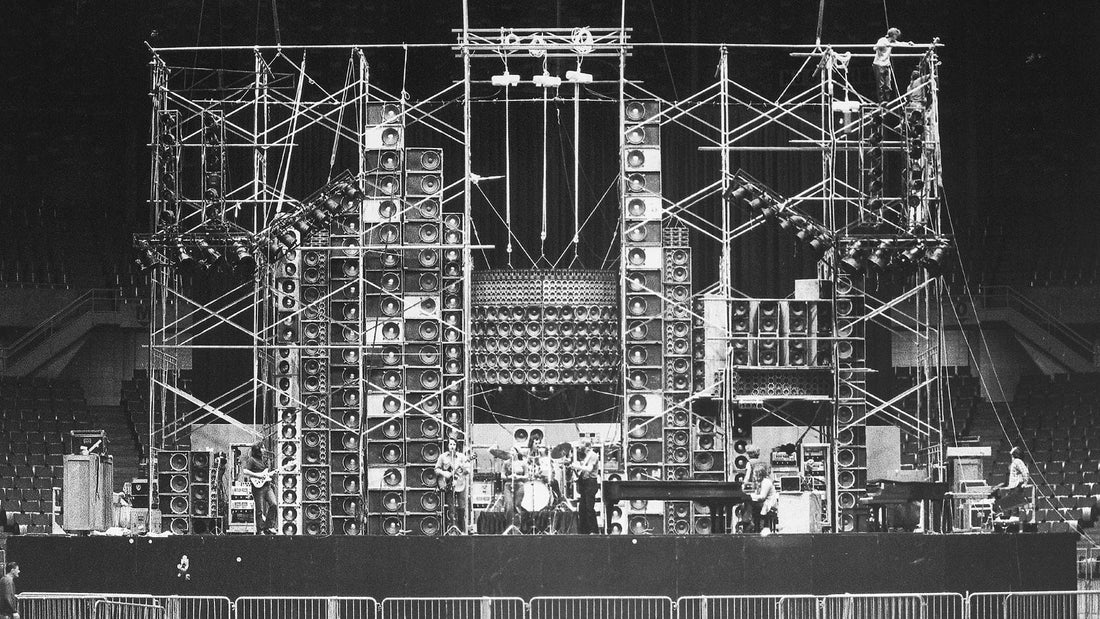To recap from Part One (Issue 99): John Meyer is a pioneer in the field of sound reinforcement. Meyer Sound equipment is used by a who’s who of artists, in touring productions like Cirque de Soleil and in concert halls and theaters around the world. Meyer began his professional career in 1967, worked with the Grateful Dead on their famous Wall of Sound and continues to innovate today. John Meyer graciously took the time to share some of his insights with John Seetoo for Copper.
John Seetoo: Your innovations in audio systems include incorporating technologies from other industries. For example, the Meyer X-10 High Resolution Linear Control Room Monitor used your Pressure Sensing Active Control or PSAC technology, which was developed from a circuit used in United States Air Force stealth aircraft. (PSAC uses a pressure sensing device in front of the woofer to track the driver’s output pressure, then sends the measurement into a circuit that compares it to the input signal and corrects the behavior of the woofer accordingly. The PSAC circuit could do this on a microsecond time scale, yielding superior linearity and resolution.) The amplifier was an analog, solid-state Class H which is a modified version of a traditional Class A/B amp.
How did you find out about the circuit and then what hurdles did you have to overcome to access it and modify it for Meyer Sound?
John Meyer: We were collaborating with the University of California mechanical engineering department, where they were working on controlling high-speed jet fighters, which you can’t control strictly manually. You have to use fly-by wire steering control with computers. The jets are going too fast and too many things have to change all at once [to be operated by manual control]. So, with these adaptive systems, we wanted to see if we could apply them to a loudspeaker.
As a loudspeaker driver moves, it may not move perfectly the way you want it to. However, you can use adaptive systems to correct for that and make it behave more like an ideal loudspeaker. So the X-10 became a project of making the low-frequency driver of the speaker behave correctly, to produce what it’s supposed to, using this kind of adaptive circuitry. And it’s difficult, because you’re predicting the behavior of the speaker. You have to implement a model of the speaker’s behavior so that you can predict what’s going to happen and correct for it.
For that, we had a little computer that simulated what the problems were that we were trying to crack. These are very complex problems and solving them turned out to be very, very expensive to implement.
In the end we decided to go back toward more of a straightforward linear approach, meaning that the speakers would have low distortion on their own, rather than using the kind of adaptive technology used in the X-10 and the PSAC to try to correct the non-linearities in the speaker’s performance. It’s just difficult. But we learned a lot from that experience and that product.

The Meyer Sound factory in 2007.
Someone out there might remember the early days when Meyer Sound used tube amplifiers, which people loved because they sounded good. Then solid-state amplifiers came out and they didn’t sound as good as the tube ones, but they measured better.
It turns out that it’s hard to measure all the things that we can hear. It’s like trying to measure wine with chemistry. Sound is subtle. You can measure a lot of information, but it’s very difficult to get all the information just from testing. It took a long time for solid-state amplifiers to start sounding good.
With technology, you can encounter a lot of complicated things which make it difficult to figure out what a product is actually doing, and what you want it to do. At Meyer Sound we tend to try to keep things as simple as we can. Our products are easy to use. They’re easy to repair, they’re easy to service, and they are understandable. If something breaks, you can send the customer a new part; it doesn’t require a whole new realignment of the speaker or system.

Meyer Sound’s HD-1 High Definition Audio Monitor.
JS: Do you find that Meyer’s Sound’s breakthrough designs in powered loudspeakers, time-aligned speaker arrays and other advancements have taken a lot of the analytical guesswork work out of the equation for live sound engineers?
As a parallel development: as houses of worship, recreational parks and other types of spaces are demanding ever-better quality sound reinforcement, the experience and skill set of the engineers may vary widely. Is Meyer Sound looking to expand into serving these markets in addition to your live sound clientele?
JM: If you remember cars from the 1950s, they had a lot of controls on the dashboard. There were some cars where you could even change the engine timing. You could change all kinds of things, with chokes for example, but which made it harder to know how to start the car. What the car makers finally figured out is that things like water vapor, temperature and even changes in altitude could be taken care of with a computer. So now the driver didn’t have to constantly know so much. The goal was to simplify the basic car so all the driver has to do is step on the gas and shift – and eventually even shifting went away.
In a similar manner a lot of what we’ve done is to take a lot of the complexity out of sound reinforcement systems, and having self-powered loudspeakers helps with that. You don’t have to try to set up an amplifier and make it work with the speakers and the protection circuitry. Basically our systems work right out of the box. You put the system up in the venue and it sounds pretty good to start with in what we call our Native Mode. Then the sound engineer can tweak it a little bit with their controls they have in their mixing console.

Meyer Sound rocks the crowd at Denmark’s Roskilde Festival, 2018. Photo courtesy of Ralph Larmann.
So, I think that one of the things that has become valuable as sound reinforcement systems have evolved over the decades is the application of technology to make the systems easier for people to use. People have to remember that in the early days of the Grateful Dead, it took a week to set up the Wall of Sound system! That’s just not acceptable anymore. With today’s touring schedules and economics, systems now have to be loaded in and set up in the same day. Load in the morning and do a show that night. No one is going to pay for a week of stadium time to get the system set up. The Wall of Sound and things like that were really, really time consuming. I think it took 10 days in New York to have the whole thing up and running, at this huge cost.
JS: There’s a second part to my question: houses of worship, recreational parks and other spaces other than the usual, traditional live sound venues are demanding better quality sound reinforcement. However, the experience and skill set of the engineers or even the laymen or volunteers who are tasked with operating the systems can vary widely. Is Meyer Sound looking to serve these markets in addition to your more traditional professional clientele? And if so, how? The analogy would be similar to how Apple and Microsoft opened the computer market to individuals by making their products easier to use, after decades of corporate and government exclusivity.
JM: Yeah, substantial improvements could be made in general in the overall quality and usage of sound reinforcement in general and we’re definitely looking at that. It’s a different business model for us in a sense that we’re currently in a small, highly professional market. People know exactly what they want to buy. We’re fitting in a narrow market that is very sophisticated. This new, broader market has to be simpler.
Again, one of the great things that Apple did when they introduced the Mac is that they made their computers very intuitive to use and got rid of the command-line interface and all kinds of complexity. It made computers accessible to everyone, not just engineers and programmers. That was their big breakthrough. It will require that kind of thinking, on how to make our future audio systems intuitively easy to use, and computers will help with that. So those exciting new markets are a big challenge.
The final part of this interview will appear in Issue 101.



